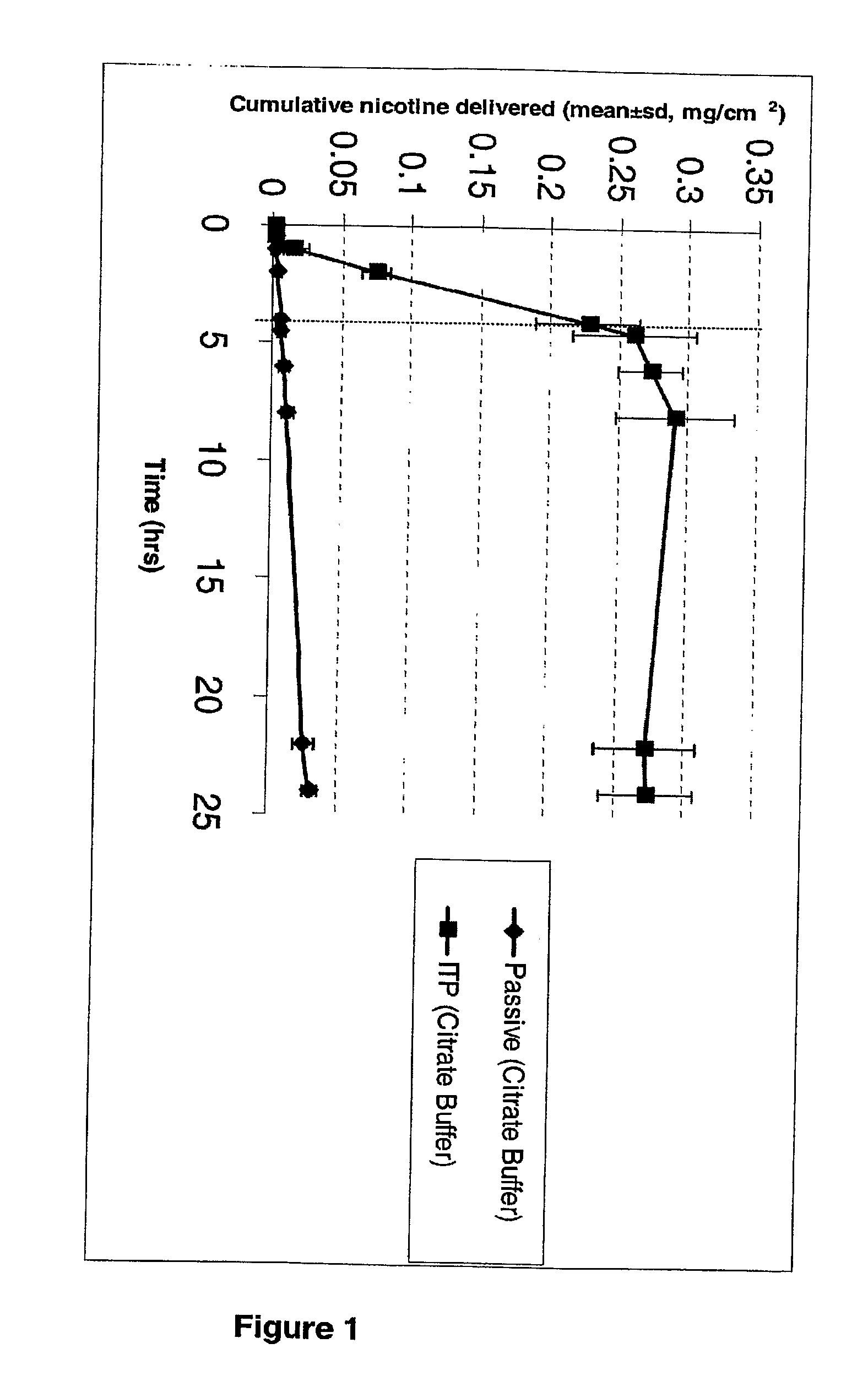Iontophoretic Transdermal Delivery of Nicotine Salts
a technology of ionophoretic and nicotine salt, which is applied in the direction of biocide, drug composition, therapy, etc., can solve the problems of tobacco products that are becoming increasingly restricted or outright banned in the public environment, tobacco products such as chewing tobacco, present serious health risks to users, and tobacco products that are used in tobacco products in many public environments
- Summary
- Abstract
- Description
- Claims
- Application Information
AI Technical Summary
Problems solved by technology
Method used
Image
Examples
example 1
Transdermal Delivery of Nicotine Base by Passive Diffusion and Iontophoresis
[0020]Permeation of nicotine base was studied under two different sets of conditions.[0021]i) Nicotine in 50 mM HEPES ([4-(2-Hydroxyethyl)-1-piperazine ethanesulfonic acid) buffer pH 5.5 with 50 mM NaCl.[0022]ii) Nicotine in 500 mM Citrate buffer pH 8 with 50 mM NaCl.
[0023]Nicotine is a diacidic base with pKa values of 3.4 and 8.2. It exists as a free base above pH 9. In between pH 4.8-7.5 it is present in the form of freebase and monocations. Passive transport of nicotine was higher at pH 8, when the drug predominantly exists in the non-ionized form, as compared to the monocationic form of nicotine at pH 5.5. Iontophoresis enhanced nicotine permeation compared to passive nicotine delivery in both of the conditions evaluated (FIGS. 1 and 2).
example 2
Transdermal Delivery of Nicotine Salts by Passive Diffusion and Iontophoresis in 500 mM Citrate Donor Buffer
[0024]Passive and iontophoretic permeation of nicotine salts (equivalent to 1% nicotine), specifically nicotine bitartrate and nicotine hemisulfate, were studied in 500 mM citrate buffer with 50 mM NaCl. Iontophoretic current was terminated after 4 hours. The iontophoretic flux of nicotine was similar in both the salt forms, which was less than the flux from the passive delivery of nicotine base at pH 8 (FIG. 3). When pH of the donor solution was measure after the experiment, it was found that the pH of donor solutions did not change.
example 3
Comparison of the Iontophoretic Delivery of Nicotine Bitartrate Salt in 50 mM HEPES Donor Buffer Vs 500 mM Citrate Donor Buffer
[0025]Iontophoresis of nicotine bitartrate salt was studied in 50 mM HEPES buffer pH 5.5. Nicotine bitartrate salt decreased the pH of HEPES buffer to about 3.5, which was then adjusted to about pH 5.5 with NaOH.
[0026]From the comparison plot (FIG. 3), it is seen that the flux of nicotine from 50 mM HEPES buffer is higher than the nicotine flux from a 500 mM citrate buffer. It appears that a higher buffer strength of citrate buffer contributed to more buffer ions which competed with the drug ions to be delivered across the skin, thereby reducing the nicotine permeation. There was some indication of this in the conductivity measurements. The 500 mM citrate buffer solution had a conductivity of 66400 μmhos / cm, compared to 16300 μmhos / cm measured for the 50 mM HEPES buffer solution. The pH measure at the end of the experiment with 50 mM HEPES solution indicated...
PUM
| Property | Measurement | Unit |
|---|---|---|
| Time | aaaaa | aaaaa |
| Time | aaaaa | aaaaa |
| Time | aaaaa | aaaaa |
Abstract
Description
Claims
Application Information
 Login to View More
Login to View More - R&D
- Intellectual Property
- Life Sciences
- Materials
- Tech Scout
- Unparalleled Data Quality
- Higher Quality Content
- 60% Fewer Hallucinations
Browse by: Latest US Patents, China's latest patents, Technical Efficacy Thesaurus, Application Domain, Technology Topic, Popular Technical Reports.
© 2025 PatSnap. All rights reserved.Legal|Privacy policy|Modern Slavery Act Transparency Statement|Sitemap|About US| Contact US: help@patsnap.com



